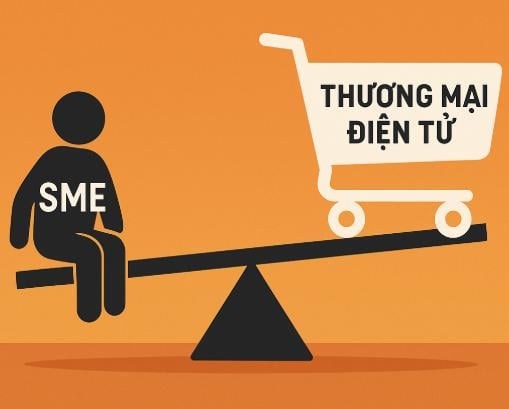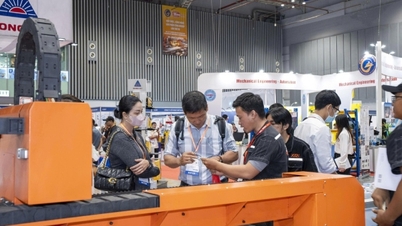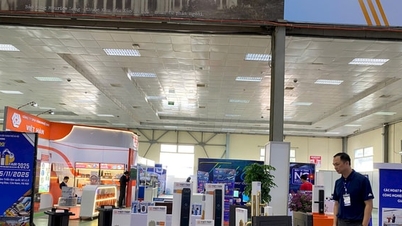Uneven growth
According to Metric's report, in the first quarter of 2025, total e-commerce sales reached 101.4 trillion VND, up 42.29% over the same period last year. But if we look deeper into the structure, it is easy to see that the differentiation is becoming more and more obvious: Large enterprises account for the majority of the market share, while SMEs "struggle" with low revenue and high costs.
SMS is gradually losing strength and being pushed out of the e-commerce game. Illustration photo
Specifically, about 38,000 small shops will have no orders in 2025; the number of shops with orders will also drop sharply from 700,000 to 626,000. This is not just a temporary phenomenon but is becoming a worrying trend. In reality, businesses that do not have enough strength to run ads, and are unable to retain customers with continuous promotions, are easily "crushed" by the big guys.
Not only are SMEs weak in budget, they are also passive in controlling data and customer journey. Being almost completely dependent on foreign e-commerce platforms makes them unable to control their buyer files, unable to control feedback information, and difficult to maintain long-term connections.
On the contrary, large corporations such as Unilever, Samsung… possess prestigious brands, professional marketing teams and are willing to "pump" billions of dong into advertising on the floor. For them, increasing operating costs is not a problem. In fact, higher costs reduce competition from small businesses, thereby creating a soft monopoly. Therefore, SMEs are gradually being pushed out of main search positions, losing impressions, reducing conversion rates and finally withdrawing from the floor.
According to NielsenIQ research, consumer shopping behavior is changing rapidly. Consumers are no longer loyal to a single platform. Ms. Le Minh Trang, SMB Associate Director of NielsenIQ Vietnam, analyzed that they can view products on TikTok, find good prices on Shopee, complain on Facebook and receive goods at the store.
Thus, the "omnichannel" model requires businesses to continuously synchronize data and optimize experiences across all channels, which is difficult for SMEs to meet if they operate alone or according to the traditional model.
In particular, AI is becoming a popular tool in e-commerce. From product recommendations, demand analysis, content personalization to customer care support. Thus, AI performs better than humans in many stages, but SMEs, due to lack of technological and financial capacity, have difficulty applying AI systematically, they are left behind in a technology game that should be an equal opportunity.
SMEs need to transform to avoid being eliminated.
According to Mr. Do Huu Hung, CEO of Accesstrade, SMEs cannot forever follow the "tail" of large e-commerce platforms. It is time for small businesses to be more proactive and design their own ecosystem. The simplest and most feasible way is to build a separate e-commerce website, where SMEs control all operations, customer data and brand strategy.
Users are increasingly using AI to analyze goods and prices when shopping on e-commerce platforms. Illustration photo
In fact, this model has brought good results to businesses such as Mobile World or Long Chau Pharmacy. They did not abandon the platform, but proactively guided customer behavior from social networks to their own websites, creating a more effective sales funnel.
In addition, SMEs also need to take advantage of support platforms such as Google, Zalo, YouTube, combine livestream, customer care via chatbot and especially apply simple AI tools (such as automatic product suggestions, customer classification) to save on personnel costs while still optimizing efficiency.
Another potential strategy is to build clusters of SMEs in the same industry. For example, a cluster of fashion SMEs in Ho Chi Minh City can rent warehouses together, share transportation costs, promote geographically, and exploit customer data together. This model is not new in the world but is rarely applied in Vietnam, while it can help SMEs overcome resource constraints in a smart way.
According to Ms. Le Thi Ha, Head of the Department of E-commerce Management ( Ministry of Industry and Trade ), consumers “are increasingly using AI, are interested in experiences and are attracted by entertainment in shopping”. Thus, digital transformation is not just “following trends” but a condition for survival. To do that, SMEs need a long-term strategy, starting with relearning how to approach customers in the digital age.
However, many opinions also say that it is impossible to just ask SMEs to swim alone in the harsh digital ocean, the state needs to intervene more strongly, such as supporting preferential capital for domestic e-commerce projects, developing shared logistics infrastructure, creating a fair playing field in terms of taxes between domestic and foreign enterprises.
Most importantly, it is necessary to invest in “made in Vietnam” e-commerce platforms to be competitive with foreign platforms, but prioritize policies specifically for domestic SMEs (free initial commission, communication support, synchronized shipping...). Once there is a domestic e-commerce infrastructure, SMEs can not only sell domestically but also reach out internationally in a more proactive and sustainable way.
SMEs are an important pillar of the Vietnamese economy, but if they continue to be "swallowed" in the e-commerce playground, not only will tens of thousands of businesses be wiped out, but the momentum for digital growth will also decline significantly. Accordingly, Mr. Nguyen Ngoc Dung, Chairman of the Vietnam E-commerce Association, affirmed: "E-commerce businesses must be pioneers in applying new technologies. AI is no longer a question of "whether to use it or not" but "what AI are you using" and "how to train it".
This statement is not only true for large e-commerce platforms but is also especially necessary for SMEs if they want to survive in a constantly changing market. According to Mr. Dung, in the context of e-commerce changing every day, if SMEs do not transform themselves, they will be eliminated by the system, because the market will not wait for slow people. However, with the right strategy, plus support from policies, SMEs can completely rewrite their success story in the era of comprehensive digitalization.
According to News and People Newspaper
Source: https://doanhnghiepvn.vn/cong-nghe/doanh-nghiep-vua-va-nho-can-lam-gi-de-khong-bi-nuot-chung-tren-thuong-mai-dien-tu-/20250516061745936




![[Photo] Unique art of painting Tuong masks](https://vphoto.vietnam.vn/thumb/1200x675/vietnam/resource/IMAGE/2025/11/14/1763094089301_ndo_br_1-jpg.webp)
![[Photo] Special class in Tra Linh](https://vphoto.vietnam.vn/thumb/1200x675/vietnam/resource/IMAGE/2025/11/14/1763078485441_ndo_br_lop-hoc-7-jpg.webp)


![[Photo] Deep sea sand deposits, ancient wooden ship An Bang faces the risk of being buried again](https://vphoto.vietnam.vn/thumb/1200x675/vietnam/resource/IMAGE/2025/11/13/1763033175715_ndo_br_thuyen-1-jpg.webp)



































































































![Dong Nai OCOP transition: [Article 3] Linking tourism with OCOP product consumption](https://vphoto.vietnam.vn/thumb/402x226/vietnam/resource/IMAGE/2025/11/10/1762739199309_1324-2740-7_n-162543_981.jpeg)






Comment (0)